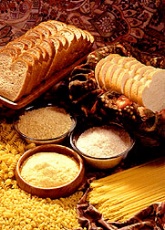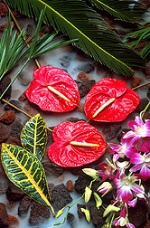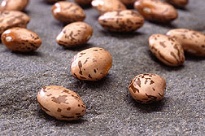Conserving the World's Plants
|
Watch a video to learn about this and other discoveries that improve our daily lives.
|
In 1898, experts were predicting food shortages and famine because increasing population would overtake our ability to grow sufficient wheat by 1931. They may have been right--except 1898 was also the year U.S. Department of Agriculture special agent Mark A. Carleton was sent on his first plant exploration trip to Russia. He brought back new durum and hard red wheat varieties to grow in the United States. Five years after the introduction of wheat from Russia, wheat production in the United States exploded from 60,000 to 20 million bushels a year. Not only did the drought tolerance of these new varieties open up the Great Plains and the Northwest for wheat growing, the durum wheat tasted better in pasta, and the hard red wheat made better bread. The USDA official who sent Carleton on his 1898 collecting trip would later write, "We have forgotten how poor our bread was at the time of Carleton's trip to Russia. In truth, we were eating an almost tasteless product, ignorant of the fact that most of Europe had a better flavored bread with far higher nutritive qualities than ours." One hundred years later, USDA plant exploring and collecting, now under the direction of the Agricultural Research Service's National Germplasm Resources Laboratory, is still a critical ingredient in maintaining and expanding agriculture's ability to feed an ever-growing population. |
|
|
So Many Plants, So Many Reasons Plant exploring and collecting are essential for agriculture because crops must be continually enhanced to overcome diseases and pests, expand drought and temperature tolerance, adapt plants to new growing conditions, and make them more productive, nutritious, durable, or simply better tasting. The plants that collectors bring back often provide the genetic material for breeding improved varieties. "No one country or even one continent has all of the genetic resources necessary to sustain crops at the level that is needed today," says Allan K. Stoner, leader of the ARS germplasm laboratory. "Conditions and needs continue to change, and collecting genetic diversity is how you have the resources to deal with them." Only 1 of the top 20 major world crops originated in North America: the sunflower, which now ranks among the top 4 oilseed crops worldwide. Of course, there are many plants indigenous to North America--including crops like strawberries, blueberries, cranberries, forage grasses, pecans, grapes, and tepary beans--that are collected by both U.S. and foreign plant explorers. Interestingly, it was Russian researchers who used U.S. sunflower germplasm to breed the varieties that started the sunflower oil industry. "But our major crops came here from elsewhere," says Stoner. "And when you are looking for genetic diversity, the most important places to look are the centers of origin for crops--that is, the places where they evolved and where people have been cultivating them the longest. "The traditional varieties that farmers have been growing for centuries may not be as highly productive as current varieties, but they can have genetic traits that are exactly what we need to overcome a pest or disease problem," he says. The wheat that USDA plant explorer Jack R. Harlan and his Turkish colleague Osman Tosun collected from a field in Fakiyan Semdinli, Turkey, in 1948 is a perfect example. At the time the sample was taken, the wheat looked terrible--it lodged, had no winter hardiness, and was susceptible to leaf rust. By itself, "it was a hopelessly useless wheat but was dutifully conserved," Harlan wrote of the wheat that was listed simply as Plant Introduction 178383. |
|
|
But 15 years later, when U.S. wheat breeders were looking for a way to breed resistance to a stripe rust outbreak, PI 178383 was found to have resistance to 4 races of stripe rust, 35 races of common bunt, and 10 races of dwarf bunt--as well as tolerance to flag smut and snow mold. Today, PI 178383 appears in the pedigree of virtually all the wheat grown in the Pacific Northwest. Interestingly, it may turn out that PI 178383 did not actually originate in southern Turkey. In 1986, ARS plant explorer Calvin R. Sperling returned to Fakiyan Semdinli to collect more of PI 178383 and other possibly disease-resistant wheat. In talking with the region's farmers, Sperling discovered that they had migrated to the area only in their grandfathers' time. They had come from northern Iraq and brought their wheat along with them. Wars and political instability have precluded plant exploration of the farmers' earlier home, and no one knows if the wheat can still be found. The Why of Plant Collecting A sudden virulence in plant diseases or the arrival of new insect pests illustrates another critical reason for having a standing germplasm collection that reflects a crop's range of genetic diversity. "It represents a crucial reservoir of breeding material that can be turned to immediately for help when a crisis strikes," Stoner says. When wilt and blight became unusually virulent and threatened to kill off the Virginia spinach industry in 1920, the genes for resistance to these diseases were found in a spinach that had been collected 20 years earlier in Manchuria by a USDA plant explorer. The genetic contributions of the Manchurian spinach have spread far beyond the Virginia Savory cultivar developed to meet the original disease outbreak. Today, the genes are present in almost every multidisease-resistant spinach grown. "It is impossible to judge now just what germplasm may be essential to our future," Stoner points out. "All we can do is collect what seems to represent the diversity of a crop and its relatives and preserve it until that day in the future when a plant turns out to be the single most important source of some critical trait." |
|
ARS plant geneticist Albert E. Percival has seen this disappearance of germplasm while plant collecting in Mexico for traditional and wild varieties of cotton. "Ancestors of the fine upland cotton that is grown today in California were originally collected in the Acala Valley of Mexico in 1906 and used in a breeding program at the Agricultural Experiment Station in Texas," says Percival. But when he went to the Acala Valley in 1984 to re-collect the original germplasm, he couldn't find any cotton at all. "Local farmers told me that in the 1970s, a Mexican consortium decided they were going to try to grow cotton for more than local use--as a commercial crop. The first year they had a bumper harvest; the second year was not so good; the third year, boll weevils destroyed the crop," explains Percival. Growers decided to eradicate what was perceived as the source of the infestation--the native cottons--which did not solve the problem. Growing cotton in the region was abandoned. "There wasn't much left to collect. It would have been nice to have preserved those varieties for the future," says Percival. "There may have been genes for lint quality or some other traits that we would like to breed into today's cotton. Now they may be gone forever," he says. Other times, it is the habitat as a whole that is in danger. For example, Percival is concerned about an interesting race of cotton relatives--one with twice the customary number of chromosomes--that exists only in a 2- to 3-kilometer stretch along the coast of the Gulf of California in Mexico and only 200 to 300 meters from the water's edge. "But this is exactly the area that a booming tourist industry is developing, building new hotels," says Percival. "Who knows if these plants will survive or disappear? Yet they could well be the source of resistance to insects." |
|
|
|
High-Impact Acquisitions Following is a tiny taste of the immense contributions made by USDA plant explorers during one of the department's longest continuous programs. Corn, dates, sorghum, soybeans, potatoes, berries, cereal grains, grapes, apples, sugar beets, forages, carrots, onions, tomatoes, lemons, and apricots--even camellias and lawn grasses--have all been introduced into the United States or improved by USDA-collected germplasm. And this germplasm has been shared with researchers, plant breeders, and farmers in hundreds of other countries. Indeed, the descendants of collected plants have literally changed the face of agriculture and gardening around the world. A few examples:
|
|
|
An International Affair Plant exploration by its very nature has always been an international activity. But now, worldwide political developments are complicating free and open access to genetic resources. USDA plant explorers have always obtained permission from a host country for collecting. Today, it is not uncommon for permission to be refused. Some germplasm donor countries feel that they have not received a fair share of the benefits derived from the plant resources originating in their countries. To help change this perception and to keep the pathways of germplasm exchange open, ARS has expanded collaborative activities associated with plant exploration, explains ARS botanist Karen A. Williams. She coordinates the ARS plant exploration program. For example, Williams recently negotiated terms with Paraguayan officials for a joint exploration trip looking for wild relatives and traditional varieties of peppers, a popular U.S. crop that is under-represented in ARS germplasm collections. During the exploration, Paraguayan scientists got hands-on experience in germplasm collection. Because Paraguay currently lacks modern facilities to maintain the collected germplasm, ARS will provide long-term storage on Paraguay's behalf. Whenever requested, samples of the germplasm will be sent back, ensuring that unique germplasm will remain available to Paraguayans--no matter what habitat or agricultural changes take place there. In addition, ARS is helping train a Paraguayan scientist in germplasm utilization. And to conserve wild peppers and other crop relatives in their natural habitats, a study of the distribution of these plants is being conducted using information from previous germplasm and botanical samples. Working with Paraguayan institutions, ARS scientists will provide recommendations for creation of protected areas for these plants. "Both the United States and Paraguay are benefiting from collaboration on the pepper exploration and associated activities," Williams says. Germplasm collected on USDA-supported explorations is deposited into the National Plant Germplasm System, where it is freely available to breeders and other researchers. Agriculture around the world, including in the United States, has benefited enormously from the extensive amount of germplasm that has been made available since the beginning of the USDA program in 1898, Williams says. |
|
|
In the Beginning The formal USDA collection program began with a single Congressional appropriation of $20,000 in 1898 and the hiring of David Fairchild as chief, a position he held until 1928. What Fairchild's plant explorers brought back during this period profoundly affected agriculture in the United States. In addition to Carleton's Russian wheat, avocados, navel oranges, and other tropical fruit varieties collected by Wilson Popenoe in South and Central America created new U.S. industries. The rice brought back by Seaton A. Knapp from Japan not only opened up rice-growing in Louisiana and Texas, it turned the United States into an exporter of rice instead of an importer. Fairchild himself brought back dates, pima cotton, pistachios, gooseberries, olives, walnuts, and many other specialties. And then there was Frank N. Meyer. Considered the dean of USDA's agricultural explorers, from 1905 to 1918 he introduced thousands of plants. Although he is not well known to the public today, consumers benefit from the bounty he brought back every time they shop for groceries. Collecting mostly in Asia and Russia, Meyer sent back new crops--from alfalfa sprouts to zoysia grass. Apples, barley, chestnuts, bean sprouts, Chinese celery-cabbage, and the Meyer lemon, which is an important source of frozen lemon juice and is grown commercially in Texas, South Africa, and New Zealand--these just scratch the surface of what Meyer collected. He also brought back landscape plants and ornamentals: Bradford pears, dwarf lilacs, Amur cherry, gingko trees, and a rose that provided the rootstock on which millions of roses still bloom in the United States each year. Most widely used of all the drought-resistant trees that Meyer collected were Siberian and Chinese elms. When the drought of the 1930s began to turn the prairie states into the Dust Bowl, Meyer's elms formed a large part of the 17,000 miles of shelterbelts that were created to reduce wind erosion. These tree-lined windbreaks planted between 1935 and 1942 helped conserve millions of tons of soil. One of Meyer's most significant contributions was soybeans. Before he went to China in 1905, only eight varieties of soybeans were grown in the United States, and these were for animal forage. Between 1905 and 1908, Meyer added 42 new soybeans, which have parented thousands of varieties over the years. Among the soybeans that he collected was the one that gave rise to soybean oil production, an industry worth billions of dollars today. One contribution of his did not quite take: Meyer was ahead of his time in the early 1900s, when he advocated that the United States should pick up on an Asian soybean industry and begin producing a food called tofu. It is hard to track the impact of what Meyer and other USDA explorers brought back, because it can be decades before selections from a collected plant can be further developed into a new variety. For example, the zoysia grass that Meyer collected in the early years of the century did not evolve into a commercial variety until 1951. Fairchild established the plant inventory system that remains in operation today. Each accession that enters the germplasm system, whether it is collected by a plant explorer or the result of a breeding program, is given a plant introduction number. The first, PI 1, was a cabbage accession from Moscow, Russia. Collected in 1898, it was said to mature a little earlier than the Jersey Wakefield but to form heads too small for market. Recently, PI 600,000 was awarded to a pollinator sunflower with shorter-than-normal height. It promotes high yield in hybrids and was developed in an ARS breeding program. |
|
Plant Introduction Stations New accessions today receive PI numbers only after an evaluation is done to determine that a plant represents new germplasm for the collections. Germplasm is often sent to one of four Regional Plant Introduction Stations managed by ARS at state agricultural experiment stations (SAES) at Ames, Iowa; Geneva, New York; Griffin, Georgia; and Pullman, Washington. These sites were originally chosen to represent the main agricultural environments in the United States. The plant introduction station system created in 1948 by USDA and the SAES to maintain the collections of different crops is celebrating its 50th anniversary this year. ARS also set aside some locations for specialized germplasm collections and in the 1980s, again with the SAES, established repositories for clonally propagated fruit and nut crops. All of these sites concentrate today on maintaining, characterizing, and distributing the active collections for particular crops. "Because the collections have gotten so large and resources are always limited, we focus on a core collection--about 10 percent of the main collection--that reflects the basic genetic diversity of a crop that a researcher would need to screen to find a source for a particular trait," explains Philip L. Forsline, who is curator of the ARS apple collection at Geneva. It keeps cool-season grapes, Brassica (broccoli, cauliflower, mustard, turnip), tomatoes, and some minor crops, as well as the apples in which Forsline specializes. "In the apple collection alone, we have more than 2,000 named varieties. However, most of them, whether they are French cider apples or domestic varieties from North America, New Zealand, or South Africa, come from a very narrow genetic base," Forsline says. "That is why we have made four trips since 1989 to collect wild varieties in Kazakhstan, the center of origin for apples." Whether breeders are trying to create a new flavor or respond to an outbreak of apple scab, they turn to the collection at Geneva as the definitive reservoir of apple genes. On the other hand, long-term storage of the entire germplasm collection is the job of ARS' National Seed Storage Laboratory (NSSL) in Fort Collins, Colorado. "We provide the backup to the active collections," says Steve A. Eberhart, who heads the lab. "We are sort of the Fort Knox for plants." If a tornado, fire, or other disaster ever hit one of the plant introduction stations or other ARS germplasm banks, NSSL could replace lost varieties, Eberhart explains. As one of the most advanced plant and seed storage facilities in the world, NSSL has been asked by some countries and international agricultural research centers to keep samples of their valuable collections. For example, the International Rice Research Institute in the Philippines has asked NSSL to keep a secure backup of its rice germplasm because of concern that a typhoon could destroy parts of the collection. So far, IRRI has not had losses from a natural disaster, but NSSL was able to replace a few varieties that had been lost in the normal course of growing. "The seeds we keep secure here," says Eberhart, "are truly the world's treasure."--By J. Kim Kaplan, Agricultural Research Service Information Staff. |






